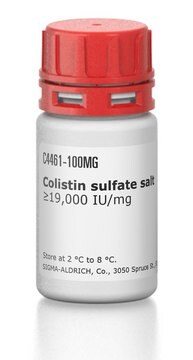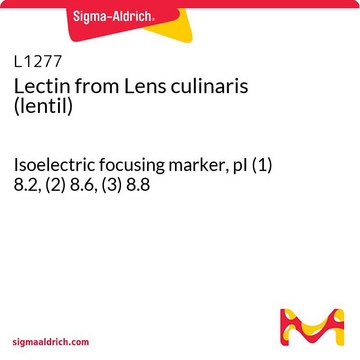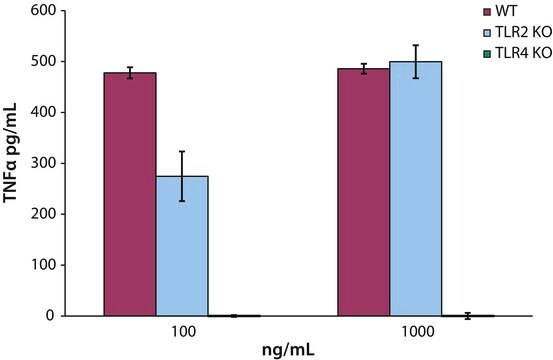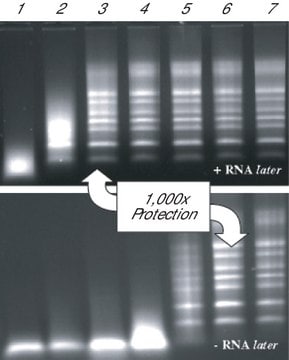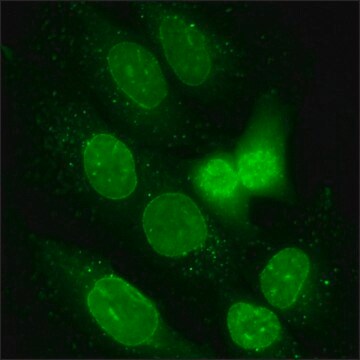L7011
Lipopolysaccharides from Salmonella enterica serotype minnesota
purified by trichloroacetic acid extraction
Sinonimo/i:
LPS
Autenticatiper visualizzare i prezzi riservati alla tua organizzazione & contrattuali
About This Item
Prodotti consigliati
Origine biologica
Salmonella enterica (Serotype minnesota)
Livello qualitativo
Stato
lyophilized powder
Purificato mediante
trichloroacetic acid extraction
Impurezze
1-10% Protein (Lowry)
Condizioni di spedizione
ambient
Temperatura di conservazione
2-8°C
Cerchi prodotti simili? Visita Guida al confronto tra prodotti
Descrizione generale
Lipopolysaccharides (LPSs) are characteristic components of the cell wall of Gram-negative bacteria. LPS and its lipid A moiety stimulate cells of the innate immune system by the Toll-like receptor 4 (TLR4), a member of the Toll-like receptor protein family, which recognizes common pathogen-associated molecular-patterns (PAMPs).
This product is TCA extracted from Salmonella minnesota. The source strain is ATCC 9700.
Azioni biochim/fisiol
Lipopolysaccharides (LPS) are localized in the outer layer of the membrane and are, in noncapsulated strains, exposed on the cell surface. They contribute to the integrity of the outer membrane, and protect the cell against the action of bile salts and lipophilic antibiotics.
Nota sulla preparazione
The product is soluble in water (5 mg/ml) or cell culture medium (1 mg/ml) yielding a hazy, faint yellow solution. A more concentrated, though still hazy, solution (20 mg/ml) has been achieved in aqueous saline after vortexing and warming to 70-80 oC. Lipopolysaccharides are molecules that form micelles in every solvent. Hazy solutions are observed in water and phosphate buffered saline. Organic solvents do not give clearer solutions. Methanol yields a turbid suspension with floaters, while water yields a homogeneously hazy solution.
Altre note
To gain a comprehensive understanding of our extensive range of Lipopolysaccharides for your research, we encourage you to visit our Carbohydrates Category page.
Prodotti correlati
N° Catalogo
Descrizione
Determinazione del prezzo
Codice della classe di stoccaggio
11 - Combustible Solids
Classe di pericolosità dell'acqua (WGK)
WGK 3
Punto d’infiammabilità (°F)
Not applicable
Punto d’infiammabilità (°C)
Not applicable
Dispositivi di protezione individuale
Eyeshields, Gloves, type N95 (US)
Scegli una delle versioni più recenti:
Possiedi già questo prodotto?
I documenti relativi ai prodotti acquistati recentemente sono disponibili nell’Archivio dei documenti.
Zhendong Zhu et al.
Cryobiology, 88, 1-8 (2019-04-30)
Mammalian spermatozoa are highly susceptible to reactive oxygen species (ROS) stress. The aim of the present study was to investigate whether and how melatonin protects rabbit spermatozoa against ROS stress during cryopreservation. Semen was diluted with Tris-citrate-glucose extender in presence
Pei Ching Low et al.
The Journal of cell biology, 190(6), 1053-1065 (2010-09-15)
Phosphoinositide 3-kinase (PI3K) p110 isoforms are membrane lipid kinases classically involved in signal transduction. Lipopolysaccharide (LPS)-activated macrophages constitutively and abundantly secrete proinflammatory cytokines including tumor necrosis factor-α (TNF). Loss of function of the p110δ isoform of PI3K using inhibitors, RNA-mediated
Guangming Ren et al.
The EMBO journal, 38(6) (2019-02-23)
Deubiquitination of NLRP3 has been suggested to contribute to inflammasome activation, but the roles and molecular mechanisms are still unclear. We here demonstrate that ABRO1, a subunit of the BRISC deubiquitinase complex, is necessary for optimal NLRP3-ASC complex formation, ASC
Anna Lünemann et al.
Journal of immunology (Baltimore, Md. : 1950), 181(9), 6170-6177 (2008-10-23)
Microglia are resident macrophage-like APCs of the CNS. To avoid escalation of inflammatory processes and bystander damage within the CNS, microglia-driven inflammatory responses need to be tightly regulated and both spatially and temporally restricted. Following traumatic, infectious, and autoimmune-mediated brain
Ryusuke Yoshimi et al.
Journal of immunology (Baltimore, Md. : 1950), 182(12), 7527-7538 (2009-06-06)
The tripartite motif (TRIM) family member, TRIM21, is an E3 ubiquitin ligase for IFN regulatory factor (IRF)3 and IRF8 that functions in both innate and acquired immunity. It is also an autoantigen known as Ro52/SS-A. The function of TRIM21 in
Il team dei nostri ricercatori vanta grande esperienza in tutte le aree della ricerca quali Life Science, scienza dei materiali, sintesi chimica, cromatografia, discipline analitiche, ecc..
Contatta l'Assistenza Tecnica.

